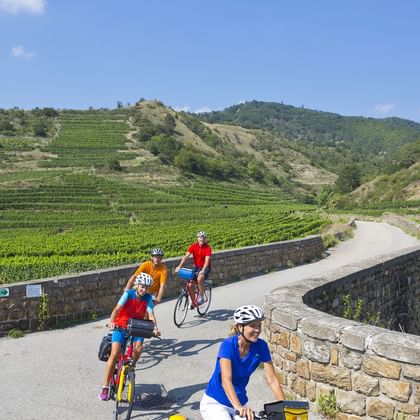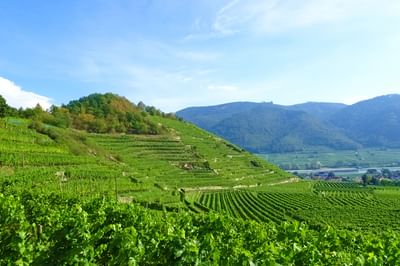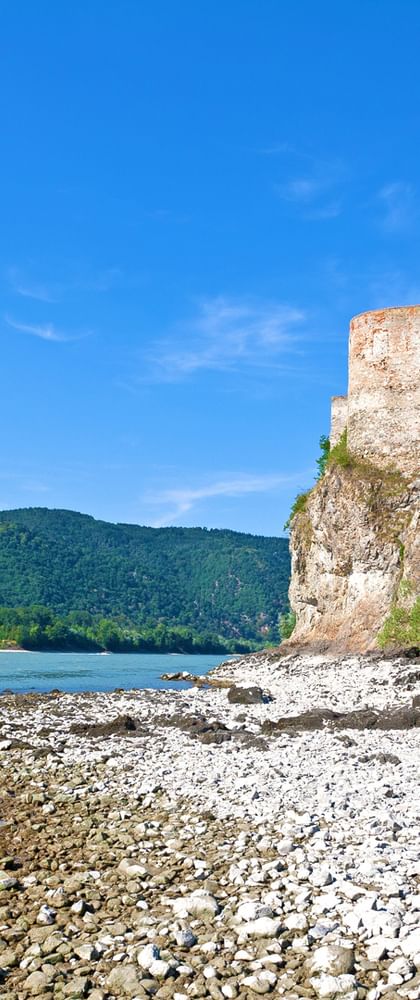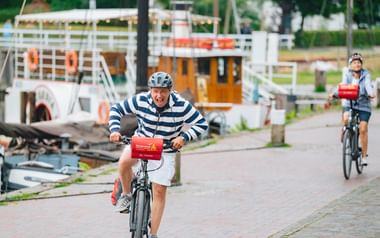The classic route follows the beautiful Danube from the source near Donaueschingen to Vienna and further on to Budapest. More recent routes even reach the mouth of the Danube into the Black Sea. But even if you only look at the classic, you will find diversity. Along the way from Donaueschingen to Budapest, there are many other attractive cities, such as Regensburg, Passau Linz, Vienna and Bratislava.
The Danube Cycle Path also takes you through beautiful natural regions such as the Gäuboden in Bavaria and the Wachau. A cycling holiday on the Danube can also take you to great buildings such as Vienna’s Schönbrunn Palace and St. Stephen’s Cathedral, Regensburg Cathedral and Budapest’s Castle Palace.
More? There’s a lot more. Depending on which stage on the Danube cycle path you choose, you may encounter traces of famous people such as Wolfgang Amadeus Mozart, Franz Liszt and Friedensreich Hundertwasser on the tour. You will experience coffeehouse and bathing culture, taste local specialities such as Sachertorte, Wiener Schnitzel, Hungarian game dishes and good wines of the Wachau. No, it never gets boring on the Danube Cycle Route. Definitely not.
There is a lot to discover on the Danube Cycle Path. Experience it for yourself on the bike trips organised by the tour operator Rückenwind Reisen.
Regensburg
Star architect Lord Norman Foster once called Regensburg one of the most beautiful cities in the world. The verdict may have been based on the city’s attractive sights, for example. The old town of Regensburg, together with the Regensburg district of Stadtamhof, has been a UNESCO World Heritage Site since 2006. The most impressive church building in the city is certainly the Cathedral of St. Peter, which is described on Regensburg. de as one of the “most important achievements of Gothic in Bavaria.
The cathedral is by no means the only magnificent church in the city. Also worth seeing is, for example, the collegiate church “Our Lady” in the style of the Bavarian Rococo. Worth seeing secular buildings in Regensburg include the Steinerne Brücke, a masterpiece of medieval architecture, the Goliath House and the Old Town Hall as well as the royal castle of Thurn und Taxis.
The many historic squares are also attractive, including the Neupfarrplatz, the Kornmarkt, the Krauterer Markt and the Domplatz. Many of these places invite you to relax in cafés and restaurants. In total, there are about 1,500 listed buildings in Regensburg, of which 984 are located in the UNESCO World Heritage Site.
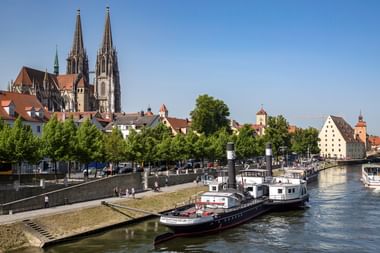
Vienna
Austria’s capital Vienna has retained the charm of the former imperial capital and residence to this day. Of course, Vienna is a modern European capital, but there are still a number of places where you can easily imagine yourself in the past centuries with a little imagination. This could be the case at Schönbrunn Palace, in the Vienna Hofburg, which today serves as a museum complex, or in the Spanish Riding School.
Vienna’s landmark is St. Stephen’s Cathedral, the most important Gothic building in Austria. As part of Vienna’s Old Town, it is part of the UNESCO World Heritage Site, like the entire Old Town, which also includes Schönbrunn Palace.
Terms such as “pronounced” and “pronounced” fit many other buildings and places in Vienna, such as Vienna’s Ringstrasse and the Belvedere Garden Palace, which divides into the Upper and Lower Belvedere. The Upper Belvedere is now home to the world’s largest Klimt collection.
Vienna is beautiful for many reasons. Vienna has many buildings from the Wilhelminian period and the Art Nouveau style. Vienna is imaginative, as evidenced by the Hundertwasserhaus. Vienna presents itself romantically on trips by Ferris Wheel in the Prater or by Fiaker through the city. And despite its more than 1. 5 million inhabitants, Vienna often seems cozy, for example in the many coffee houses and wine pubs. Without question: Vienna has many beautiful faces. Get to know them on a holiday on the Danube Cycle Path.
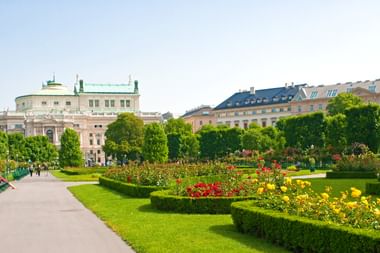
Bratislava
Bratislava is the capital of Slovakia and a border town. It is located very close to the German and Austrian borders. Particularly attractive is the old town with its many historical buildings. Here, for example, are the Old Town Hall and various very beautiful baroque palaces. The Palais Grassalkovich, today’s presidential seat of Slovakia, is part of the Rococo and Late Baroque period. Other palaces worth seeing are the Primatial Palace and the neo-classical palace Zichy.
The city’s landmark is Bratislava Castle, located on a hill above the city. Also worth seeing is the ruin of Devín Castle, a national cultural monument of Slovakia. The most important sacred building in the city is the Cathedral of St. Martin, consecrated in 1452, where Hungarian kings and queens were crowned between 1563 and 1830.
A major museum institution in the city is the Slovak National Gallery, with various art museums in Slovakia and two houses in Bratislava, where you can find, for example, Gothic and Baroque art in Slovakia, European art from the 16th to the 18th century and Slovak art from the 19th century.
Budapest
From Bratislava, the Danube Cycle Route continues to Budapest. Parts of the Hungarian capital are also UNESCO-listed World Heritage Site, namely the view of the Danube bank and the romantic Buda Castle Quarter.
Many sights such as Gellertbad, Freedom Monument, the Royal Palace, the Citadel and Castle on Buda Hill as well as the Parliament, the Grisham Palace and the Hungarian Academy of Sciences are part of the World Heritage Site. St. Matthias Church, St. Stephen’s Basilica and Vajdahunyad Castle are other interesting buildings in the city.
Budapest has a rich museum landscape, including the Hungarian National Gallery with a collection of Hungarian art, the Museum of Fine Arts and the Ethnographic Museum, one of the largest ethnographic museums in Europe. And Budapest presents itself like Vienna with a traditional coffeehouse culture that is still noticeable today.
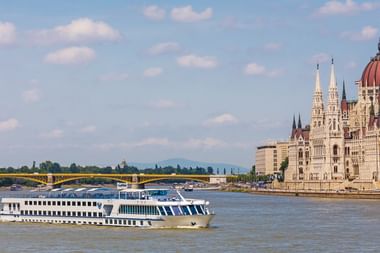
Enchanting nature on the Danube
The Danube Cycle Path leads you not only to outstanding culture, but also through fascinating landscapes. The Black Forest, the Swabian and Franconian Alb and the Bavarian Forest are just some of the regions that can be crossed on the Danube Cycle Trail. The route also leads cyclists through the Gäuboden in Lower Bavaria, for example. This rural landscape is characterized by many fertile fields in front of a low mountain scenery, which nevertheless leave enough space for a pristine nature.
The river itself also provides natural spectacles, such as the Schlögen Schlinge in Austria between Passau and Linz with its two 180-degree curves. With a bit of luck, you can still see the black stork here, which is rare in Europe today. If you ride the Danube Cycle Path from Melk towards Krems, you come to the Wachau, which is not least known for its good wines. Hungary, by the way, has a very similar region. Around the Danube Knee, an almost rectangular bend of the river in the north of the country, lies the so-called Hungarian Wachau in the Visegrad Mountains and also impresses with its scenic beauty.
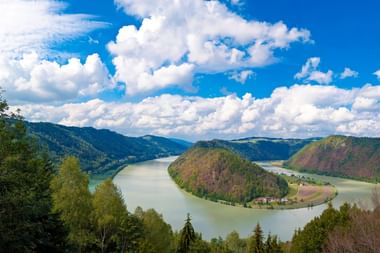
Good food and good wines
Cycling trips on the Danube Cycle Path are a culinary delight. In Vienna, for example, sweet specialities such as Sachertorte and various pastries originating from Bohemia such as palate ham make this happen. Wiener Schnitzel and Tafelspitz are two of Vienna’s hearty specialities. But it gets delicious on the Danube Cycle Path, long before you reach Austria’s capital. In Ulm you will find the Swabian cuisine with specialities such as Maultaschen and Spätzle and in Regensburg you can try pork sausages with cabbage.
And even after Vienna, the culinary delights are by no means over. Try the Poppy Seed or Nut Roll in Bratislava. In Budapest, of course, Hungarian goulash is one of the specialties and also Hungarian peppers is not just a cliché, but a widely used ingredient. Good game dishes can also be found in Budapest restaurants. And of course, you don’t have to resort to local specialities: Everywhere you are offered international cost and even as a vegetarian or vegan you will find suitable offers on the Danube Cycle Path.
Wine connoisseurs will also get their money’s worth on the Danube Cycle Path. Restaurants in the Upper Palatinate wine-growing region, Heurige in Vienna, winemakers in the Wachau: they all offer a fine wine that you should try.
